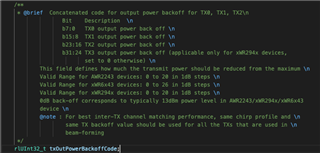Dear team,
We are evaluating AWR2944 and want to change Tx output power by changing profileCfg. We are referring the apps note (here) and change as red-highlighted to decrease the power from maximum.
We have tried it but could not confirm changing the power.(Now we are changing profileCfg and checking azimPeakSamples to confirm it)
e.g.,
profileCfg 0 79.00 10 7 20.81 0 0 24 0 512 37500 0 0 36
to
profileCfg 0 79.00 10 7 20.81 10 0 24 0 512 37500 0 0 36
<txOutPower>

1. Is this process correct to change Tx output power?
2. If no, how can we change the power?
3. If yes, how can we verify it is changed correctly? I am a little concerning about the comment, "only values "0" has been tested...".
Best regards,
Yuto



